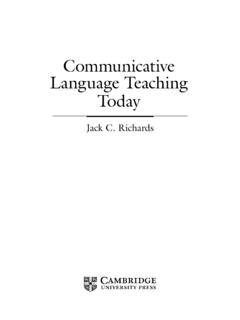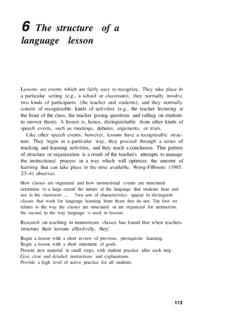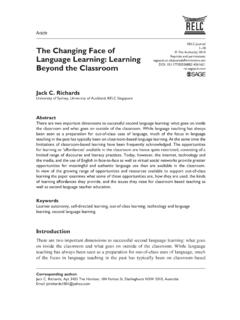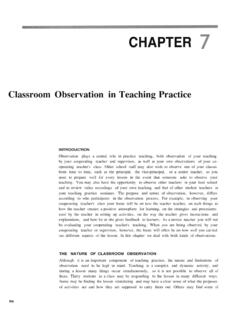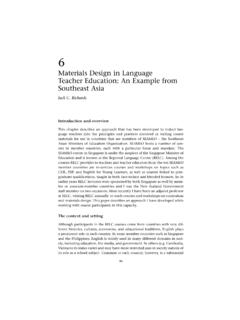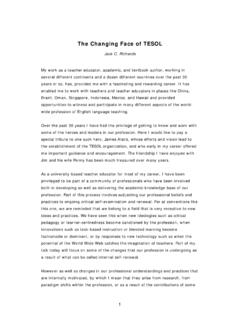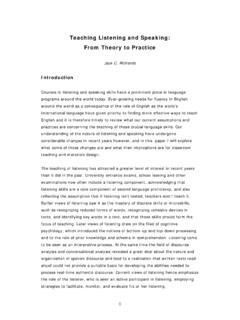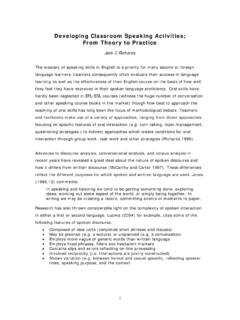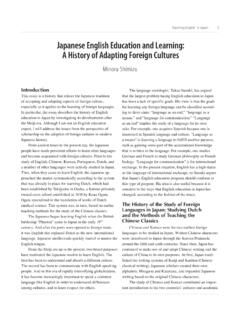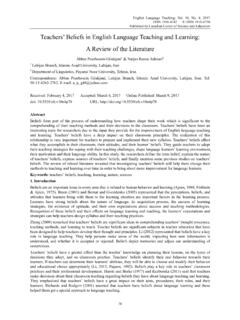Transcription of Curriculum Approaches in Language Teaching
1 473293. 2013. JournalRichards Article RELC Journal 44(1) 5 33. Curriculum Approaches The Author(s) 2013. Reprints and permission: sagepub. in Language Teaching : DOI: Forward, Central, and Backward Design Jack C. Richards University of Sydney, Australia; RELC, Singapore Abstract The development and implementation of Language Teaching programs can be approached in several different ways, each of which has different implications for Curriculum design. Three Curriculum Approaches are described and compared. Each differs with respect to when issues related to input, process, and outcomes, are addressed. Forward design starts with syllabus planning, moves to methodology, and is followed by assessment of learning outcomes. Resolving issues of syllabus content and sequencing are essential starting points with forward design, which has been the major tradition in Language Curriculum development. Central design begins with classroom processes and methodology.
2 Issues of syllabus and learning outcomes are not specified in detail in advance and are addressed as the Curriculum is implemented. Many of the innovative methods' of the 1980s and 90s reflect central design. Backward design starts from a specification of learning outcomes and decisions on methodology and syllabus are developed from the learning outcomes. The Common European Framework of Reference is a recent example of backward design. Examples will be given to suggest how the distinction between forward, central and backward design can clarify the nature of issues and trends that have emerged in Language Teaching in recent years. Keywords Curriculum development, methods, methodology, assessment, syllabus design, course design, Common European framework Introduction Language Teaching has reflected a seemingly bewildering array of influences and direc- tions in its recent history , some focusing on syllabus issues ( corpus research), some Corresponding author: Jack C.
3 Richards, RELC and Honorary Professor, University of Sydney, Apt 3403. 184 Forbes Street, Darlinghurst, 2010, Australia. Email: 6 RELC Journal 44(1). reflecting new trends or proposals in methodology ( task-based instruction), and some with a focus on learning targets ( the Common European Framework). What is it that links diverse aspects of Language Teaching such as these and which similarly estab- lishes connections between such aspects of Teaching and learning as notional syllabuses, Content and Language Integrated Learning and the standards movement? This paper seeks to answer these questions by examining the assumptions and practices underlying three different Curriculum design strategies that I will refer to as forward design, central design, and backward design. An understanding of the nature and implications of these design Approaches is helpful in arriving at a big picture' understanding of some past and present trends in Language Teaching .
4 Input, Process, Output and the Curriculum The term Curriculum is used here to refer to the overall plan or design for a course and how the content for a course is transformed into a blueprint for Teaching and learning which enables the desired learning outcomes to be achieved. Curriculum takes content (from external standards and local goals) and shapes it into a plan for how to conduct effective Teaching and learning. It is thus more than a list of topics and lists of key facts and skills (the input ). It is a map of how to achieve the outputs of desired student performance, in which appropriate learning activities and assessments are suggested to make it more likely that students achieve the desired results (Wiggins and McTighe, 2006: 6). In Language Teaching , Input refers to the linguistic content of a course. It seems logical to assume that before we can teach a Language , we need to decide what linguistic content to teach.
5 Once content has been selected it then needs to be organized into teachable and learnable units as well as arranged in a rational sequence. The result is a syllabus. There are many different conceptions of a Language syllabus. Different Approaches to syllabus design reflect different understandings of the nature of Language and different views as to what the essential building blocks of Language proficiency are, such as vocabulary, grammar, functions or text types. Criteria for the selection of syllabus units include fre- quency, usefulness, simplicity, learnability and authenticity. Once input has been deter- mined, issues concerning Teaching methods and the design of classroom activities and materials can be addressed. These belong to the domain of process. Process refers to how Teaching is carried out and constitutes the domain of methodol- ogy in Language Teaching . Methodology encompasses the types of learning activities, procedures and techniques that are employed by teachers when they teach and the prin- ciples that underlie the design of the activities and exercises in their textbooks and teach- ing resources.
6 These procedures and principles relate to beliefs and theories concerning the nature of Language and of second Language learning and the roles of teachers, learners and instructional materials, and as ideas about Language and Language learning have changed, so too have the instructional practices associated with them. Throughout the twentieth century there was a movement away from mastery-oriented Approaches focus- ing on the production of accurate samples of Language use, to the use of more activity- oriented Approaches focusing on interactive and communicative classroom processes. Richards 7. Once a set of Teaching processes has been standardized and fixed in terms of principles and associated practices it is generally referred to as a method, as in Audiolingualism or Total Physical Response. Output refers to learning outcomes, that is, what learners are able to do as the result of a period of instruction. This might be a targeted level of achievement on a proficiency scale (such as the ACTFL Proficiency Scale) or on a standardized test such as TOEFL, the ability to engage in specific uses of Language at a certain level of skill (such as being able to read texts of a certain kind with a specified level of comprehension), familiarity with the differences between two different grammatical items (such as the simple past and the present perfect), or the ability to participate effectively in certain communicative activities (such as using the telephone, taking part in a business meeting, or engaging in casual conversation).
7 Language Teaching since the late nineteenth century has seen a change in the intended outputs of learning from knowledge-based to performance- based outputs. Hence while in Europe in the nineteenth century, foreign Language learn- ing was often promoted because of the mental discipline and intellectual development it was believed to develop in learners, in the twentieth century languages were taught for more practical goals. Today, desired learning outputs or outcomes are often described in terms of objectives or in terms of performance, competencies or skills. In simple form the components of Curriculum and their relationship can be represented as follows: Input Process Output Syllabus Methodology Learning outcomes Figure 1. Dimensions of a Curriculum The pre-amble above provides the backdrop to the core thesis of this paper: Curriculum development in Language Teaching can start from input, process or output. Each starting point reflects different assumptions about both the means and ends of Teaching and learning.
8 Conventional wisdom and practice tends to assume that decisions relating to input, process and output occur in sequence, each one dependent on what preceded it. Curriculum development from this perspective starts with a first-stage focus on input when deci- sions about content and syllabus are made; moves on to a second-stage focus on method- ology when the syllabus is enacted', and then leads to a final-stage of consideration of output when means are used to measure how effectively what has been taught has been learned. However this view of the Curriculum does not in fact reflect how Language teach- ing has always been understood, theorized, and practiced in recent times. Much debate and discussion about effective Approaches to Language Teaching can be better understood by recognizing how differences in the starting points of Curriculum development have 8 RELC Journal 44(1). different implications and applications in Language Teaching .
9 This leads to the distinction I wish to make between forward design, central design, and backward design. Forward design means developing a Curriculum through moving from input, to process, and to output. Central design means starting with process and deriving input and output from classroom methodology. Backward design as the name implies, starts from output and then deals with issues relating to process and input. The three different processes of cur- riculum development can thus be represented in simple form as follows: content process outcomes Figure 2. The Forward Design Process content process outcomes Figure 3. The Central Design Process content outcomes process Figure 4. The Backward Design Process Each of these Curriculum development Approaches will now be illustrated and exam- ples given of how they have influenced issues and Approaches in Language Teaching . Forward Design Forward design is based on the assumption that input, process, and output are related in a linear fashion.
10 In other words, before decisions about methodology and output are determined, issues related to the content of instruction need to be resolved. Curriculum design is seen to constitute a sequence of stages that occur in a fixed order an approach that has been referred to as a waterfall' model (Tessmer and Wedman, 1990) where the output from one stage serves as the input to the stage that follows. This approach is described in Richards and Rodgers (2001:143-44), summarizing Docking (1994): the traditional approach to developing a syllabus* involves using one's understanding of subject matter as the basis for syllabus planning. One starts with the field of knowledge that one is going to teach ( contemporary European history , marketing, listening comprehension, or French literature) and then selects concepts, knowledge, and skills that constitute that field of knowledge. A syllabus* and the course content are then developed around the subject.
